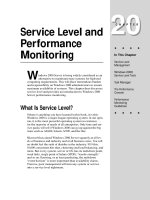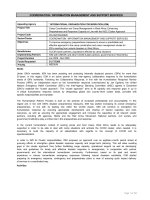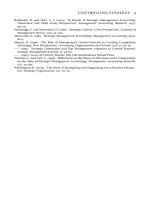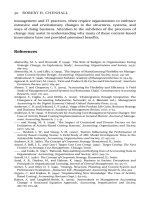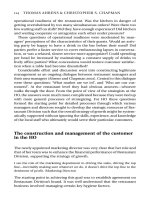Controlling Strategy Management and Performance Measurement_8 pptx
Bạn đang xem bản rút gọn của tài liệu. Xem và tải ngay bản đầy đủ của tài liệu tại đây (613.98 KB, 21 trang )
the image of four dimensions of performance measurement, and it
allowed a local interpretation of what strategy was about, namely the
local problematization of cross-functional integration. Figure 7 illus-
trates how the BSC gained its initial characteristics in ErcoPharm.
Kvadrat: BSC for planning
Kvadrat develops and markets modern soft furnishing designs and cur-
tains to the contract market and selected segments of the retail market.
Today, Kvadrat is a brand name in a professional market where quality
and design are vital parameters. Production takes place in twenty-eight
textile factories and print-works in Western Europe. In 2001/2002, with
the combined effort of some 160 employees, Kvadrat achieved a turnover
of approximately e50 million. Exports account for 80 per cent of the
turnover.
The rationale behind the development of BSC in Kvadrat was en-
hanced integration of planning activities. At the time when the BSC
was mentioned as a solution, the firm saw itself as overly creative and
innovative. The chief controller explained the rationale of the then
possible implementation as follows:
Our most important reason for implementing balanced scorecard was that we
needed a planning culture at that time. The employees are not good at writing
down what they wanted and committing themselves to what they have planned.
If plans are written, like in BSC, you can actually check whether you have done it
or not afterwards. Kvadrat is a creative company and we think it is important
that we’ve got the spirit—creativity—in the air. However, the creative culture can
be hard to handle. It cost a lot of money and can be a problem when we want to
produce things and get them out of the door. We simply have to plan in order to
survive. People have to commit themselves.
In Kvadrat the BSC was mobilized as a means to promote a planning
culture, which stood in contrast to the reliance on the power of individ-
uals’ pursuance of creativity and innovation. The BSC was presented as
a mechanism to express goals, ambition, and measures so that reporting
and evaluation could be performed. The notion of performance came
into light as accountability to plans. This was the basis for developing a
planning culture, it was argued.
The BSC was launched as a tool to be used by the individual
employee for his or her own planning. The process was centred on
STRATEGIES AND ORGANIZATIONAL PROBLEMS 135
‘mini-scorecards’—personal BSC where each employee had drawn up
his or her own quantified goals related to the work process. The chief
controller explained:
The planning our employees carry out now is framed by balanced scorecard.
They plan through their ‘mini-scorecard’. They set up goals and measures for
their plans and relate them to specific activities. They explicate activities, time
them and reflect upon what the realisation might be dependent upon—interde-
pendencies and so on. Of course they also address issues of performance directly
because they commit themselves to a target.
A powerful aspect of the BSC, according to the CEO, was that it drew on a
non-financial language. This helped make the creative culture a planned
one, because this language was direct and about the activities per-
formed by employees. They could better identify themselves with
goals and measures when the terminology was a non-financial language
about activities.
As employees recorded their own goals individuall y, a high number of
performance measures were incorporated in the BSC and it was devel-
oped as a planning tool, because it detailed the actions and effects to be
expected from the organization’s members. This use of the BSC was at
odds with the idea of BSC as a means for implementing market strategy,
the chief controller underlined, where the ambition was to involve a
much smaller number of measures. The chief controller elaborated:
The consultants that helped us implement balanced scorecard had a special idea
about how the scorecard should be and how the measures should be structured.
They began the process elsewhere. They began with the customer. In our mini-
scorecard everything is filed—all the things that the employees plan, all the
plans, goals and measures. If you for instance have an area where employees
have outlined six goals and related measures, then we think we should include
them all unless they overlap. According to the consultants you should take
another point of departure. We argued these issues with the consultant. How-
ever, we think that we use balanced scorecard for something special in our
organisation. We would like to teach people how to plan.
The chief cont roller contended that the BSC as a means to constitute a
planning culture did not necessarily match the concern for implement-
ing the customer value proposition through the BSC. In Kvadrat the aim
was to use the BSC to develop measures and goals for the individual
employee and groups, and the input for setting up measures and goals
was less a general business model than the experience of individual
labour processes.
136 ALLAN HANSEN & JAN MOURITSEN
The customer was not absent in Kvadrat’s discussions, but it was not a
problem. It was obviously important but since it was no problem there
was no reason to design and develop strategic management accounting
around the customer.
The pursuance of a planning culture affected the identity of the BSC in
Kvadrat. The issue was to get the employees to think about how they
could plan in relation to their own personal processes and how their
plans could benefit Kvadrat. Individualizing the planning process, or
perhaps more clearly adding planning and communication of objectives
to the individual’s activities, the effect was more a reflection of internal
concerns than an implementation of the customer’s value proposition.
The ‘bottom–up’ planning process was not to accommodate the cus-
tomer but to teach the employee to plan. The development of planning
capabilities was singled out to be the problem, which—if solved—would
have important (‘strategic’) implications for how the firm would con-
duct its affairs. The drive towards planning, irrespective of their know-
ledge that the BSC was about the customer (it was claimed), was a big
issue that was seen to transform the identities of employees and thus
construct a completely new company where the path into the future was
laid out much more coherently (and also linearly) than before.
In this sense Kvadrat’s BSC resembles a conventional BSC, but it looks
different because the ambition is to use it to inscribe all employees and
make the sum of employee goals the firm’s goals. Among managers there
was an understanding that employees were capable and resourceful and
therefore that in a sense the capabilities of employees were such that
they could override the specific concern for the customer. The collective
of creative individuals could even know more about the customers’
Creative
culture
Slack
Planning
The balanced
scorecard
Individual
labour
processes
Mini
scorecards
High number
of measurements
Problematization:
Scorecard
characteristics:
Figure 8 Organizational problems and the BSC in Kvadrat
STRATEGIES AND ORGANIZATIONAL PROBLEMS 137
needs than customers would themselves know, and possibly therefore
the initial marginalization of the customer comes back in another way,
not through the wants expressed by customers, but perhaps via the
coherence of the capabilities that increased planning could do for the
development of interesting actions—also for customers. The problem of
a creative culture was mitigated via a BSC, and the resulting planning
culture would have lasting (‘strategic’) effects on the operations of the
firm. Figure 8 illustrates the role of BSC in Kvadrat.
Columbus IT Partner: BSC for benchmarking
Columbus IT Partner, founded in 1989, is a leading supplier of business
management systems for the mid-market, and a global partner of
Microsoft Business Solutions. Columbus IT Partner had in 2001 approxi-
mately a turnover of e100 million and more than 850 employees in
twenty-six countries. Headquartered in Copenhagen, Denmark, the
Columbus network of strategically located subsidiaries in Europe, Af-
rica, Asia, and the Americas ensures customers an integrated standard
approach worldwide, supported by local knowledge.
Since it started, Columbus has experienced high growth and in par-
allel with its increasing size it has faced a problem of controlling expan-
sion. Particularly, there was an increasing problematization of the
variation in the execution of key processes, and the claim that stand-
ardization was needed was increasingly aired. Through standardized
processes the expectation was that sales divisions around Europe
could transfer knowledge among each othe r. The chief controller de-
scribed growth and the problem of lack of standards and structure as
follows:
What happened was that the sales divisions were too much alone. It was clear
during the period with high growth. It was harder and harder to obtain synergy
between the different divisions unless more administrative procedures were
installed. 250 new people were employed last year. With a growth like that we
needed more structure and principles. Things do not just happen by mouth-to-
mouth. At the same time we could see that if we wanted to be aggressive and be
200 in England and 200 in Germany, there was no reason to learn the same thing
twice in each country. In addition we have learned a lot in Denmark and these
experiences had to be transferred.
The BSC was related to the salient demand for more control. At the time,
to Columbus, standardization concerned the numerous sales divisions
138 ALLAN HANSEN & JAN MOURITSEN
that were deemed to be largely similar production systems. This was the
reason that standardization could be contemplated. In Columbus the
BSC was related to the problem of benchmarking. It became a tool for
standardization. The chief controller explained:
Balanced scorecard was warmly welcomed in the sales divisions because they
saw something useful. They could also use it in the interaction with us. They
could ask: how should I do this or do you have anything in relation to this issue?
It became possible to compare Austria, US, England, etc. Some were good at
something, others at other things. They learned how to do things in respect to all
the measures in balanced scorecard, which we tried to relate to best practices. I
think that is the reason why balanced scorecard was so well accepted. The
balanced scorecard is not just a strategic measurement system, it is a short
way to do things better.
The measurements in the BSC were seen as resources for comparing
sales divisions; it was possible to compare a process in one division with
the same process in another. To facilitate comparison between sales
divisions, Columbus developed distinctions between different stages
in the development of the sales divisions; a sales division could be a
support office, a mainstream entity, or an integrator. For each of these
different organizational forms a series of key processes were set-up, and
related goals and measurements followed:
It was more a matter of comparing processes rather than talking about cus-
tomers. It was another point of departure but nevertheless crucial at that point
of time.
It was a conscious decision to make the BSC different from its stipulated
procedures. The customer had no priority in the narrative of the BSC,
and learning through benchmarking was favoured, which was an effect
of the internal problem of growth:
The basic reason why we implemented balanced scorecard was that we had
grown so much, and that it was recognized by top management that the 20
countries we were in and the new ones that were yet to come were making or
would make the same mistakes. Of course they make mistakes, but there has to
be a medium to report the mistakes and initiate a learning process and com-
municate standards for all the things that we do and the things that create value
to our organisation.
The inside was made up of operational issues and concerns of learning
from each other. Problematizing through benchmarking was an impetus
for making organizational strategy a mechanism to build efficiency into
STRATEGIES AND ORGANIZATIONAL PROBLEMS 139
operations and allow growth to happen simultaneously. Figure 9 illus-
trates the character of the BSC in Columbus IT.
BRFkredit: BSC for Business Process Reengineering
BRFkredit is an independ ent mortgage credit institut ion that offers
financial solutions and other services related to real estate and property.
BRFkredit offers loans against a mortgage on owner-occupied homes,
commercial properties, and subsidized housing. In the corporate lend-
ing segment, BRFkredit focuses on loans for office and business prop-
erties and for private rental and cooperative housing. Loans for
residential purposes account for almost 90 per cent of the total lending,
whereas office and business properties make up less than 10 per cent.
Being owned by a foundation, BRFkredit is under no pressure to pay
dividends or increase share prices. Hence, BRFkredit has its focus on
providing bondholder value rather than shareholder value. The com-
pany administered in 2001 loans for approximately e20 billion and its
equity was valued e1.2 billion.
The BSC was implem ented in BRFkredit in parallel to a BPR project.
The financial manager explained about the BPR project:
At that time we decided to change our organisation. The reason was that we
recognised that we didn’t perform well enough: too high process time and
costs.
Growth
Heterogeneity
Benchmarking
(internal)
The balanced
scorecard
Key
processes
Comparisons
(divisional)
Problematization:
Scorecard
characteristics:
Standard-
ization
Figure 9 Organizational problems and the BSC in Columbus IT
140 ALLAN HANSEN & JAN MOURITSEN
Consequently, BRFkredit initiated two BPR projects:
The first reengineering project was about improving the efficiency in the loan
processing process. The target was shorter process time, professionalism, im-
proved communication, and a higher success rate (offer vs. contract). The
second reengineering project was about the distribution channel for the private
sector, primarily the estate agents. We thought we could get more loans out
here—there was a high potential, but we really didn’t exploit our possibilities. We
also looked at other channels and also the communication between the estate
agents and BRFkredit.
To monitor BPR projects, a control system was needed, the financial
controller explained. The BPR process was extensive and complex and a
formal goal setting system was needed. The BSC became the resource
here and it was closely linked with the BPR process. The financial
manager explained:
When we started with balanced scorecard it was with a point of departure in two
BPR-processes. We found that the philosophy behind balanced scorecard easily
could be used as a tool to manage the input and the output related to the BPR
processes. When we started to use balanced scorecard the theory behind it was
quite new and we gave it our own touch. However, I think the way we used it was
powerful.
The BSC was presented as an MCS, which could control the process of
reengineering. The financial manager, and with him other top man-
agers, used the BSC to outline goals and measures and to formalize
the evaluation of the processes. They sought to grasp the change of
the processes, and the BSC gave them a framework for converting
success factors into measures and wrapping them in systems of ac-
countability:
We have used balanced scorecard to control the processes. For all the input and
output we had in the BPR process we evaluated critically the question of Critical
Performance Indicators. We went thoroughly through the two processes with
senior management and asked: what is it that we want to contribute with and
what are the results? In addition we asked: does it work? And we measured the
effects. It was the reason why we got success with balanced scorecard, I guess,
we could see what worked and what did not. We spend a lot of time deciding in
what way we should measure the effects of the reengineering work.
The construction of this BSC was built on an inside–out logic. The
processes needing revitalization were catalysts for developing stra-
tegic performance measurements and the scorecard played a role in
STRATEGIES AND ORGANIZATIONAL PROBLEMS 141
conceptualizing and understanding the organizational change initiated
by the reengineering projects. This combination between measurement
and process development was characterized as crucial by the financial
manager. He suggested:
We worked with processes and reporting simultaneously. We developed the
processes and documented the result via the numbers. The scorecard actually
reveals the way we have organised our BPR-process. These are the background
for our measures—for example: reduce our portfolio exit by xx. Now we have set-
up some five years measures based upon these criteria. We use them in our
strategy process now, and they provide the managers with some good input for
discussion.
When the BSC was implemented in BRFkredit it took its character from
the reengineering processes. Later, its identity also came from other
sources, among othe r things from the development of a new market
strategy. But in this initial stage the point of departure was the two
reengineered processes: loan processing and distribution. Figure 10
illustrates the characteristics of BSC in BRFkredit.
Discussion
The four examples presented above suggest that BSCs are mobilized
vis-a
`
-vis organizational problems that colour the scorecards’ identity.
In these cases, the BSC came from important yet distinct organizational
problems, and in its association with these problems, it gained charac-
ter. It surveyed the implementation of cross-functional integration,
Poor
performance
Problematization:
Scorecard
characteristics:
Process
reengineering
The balanced
scorecard
Communication
Decoupled
processes
Lean processes
Figure 10 Organizational problems and the BSC in BRFkredit
142 ALLAN HANSEN & JAN MOURITSEN
introduction of a planning culture, the use of benchmarking, and the
development of BP R. The BSC was bent around organizational prob-
lems, and the role of strategic performance measurement—the repre-
sentation of corporate value and coherence—in the four firms differed
dramatically. In ErcoPharm, measurements were used to link organiza-
tional entities, and therefore the attempt was to develop measurements
‘between’the processes that the representations were to integrate, while
in Kvadrat the ambition was to make individuals disclose their ambi-
tions so that some form of coherence between people could be devel-
oped via visibility into goals and objectives. In Columbus IT the concern
was to compare processes by measurement, and for BRFkredit, the
measurements were used to signify the effect of a new and transformed
process.
The situated logic of the process of developing strategic
management accounting
The specific or situated logic that guided the development of the BSC
in the four companies varied from case to case and its role was flexible
as it was related to particular organizational problems in the com-
panies. This tells us something about what it means to implement stra-
tegic management accounting in general and develop a BSC in particular.
First, there is a question about what corporate value and coherence
are. Often in the strategic management accounting literature, concep-
tualizations are extrovert and oriented towards locating the firm in its
environment. Our cases illustrate that these might be challenged be-
cause translations of value and coherence also emerge from particular
organizational problems and these problems seem to be developing
situated logic and justification of the BSC project and thus also the
role accorded to it.
Second, the implementation of a BSC is itself a process that involves
complements, overlaps, and conflicts between various articulations of
what its purpose is to be. In the cases we found a discussion of what the
BSC could achieve by itself and what it was supposed to do in the firms.
This included an explicit discussion of what parts of the BSC were not
relevant. It appeared, at least, that project managers were conscious of
possible differences between what they would term the ‘theory of the
BSC’ and the way they wished to draw it into their firms. They realized
that BSC could be used for many other things and have very different
STRATEGIES AND ORGANIZATIONAL PROBLEMS 143
presentations from what they considered to be the norm of a BSC. To
project managers this did not invalidate the BSC; it gave it new power. It
could be bent towards purposes so that a local identity could be upheld
and yet, at the same time, the notion that BSC was implemented, and
not something else, could be also be upheld.
Third, as a mechanism for strategic management accounting in the
cases the BSC safeguarded the notion of strategy so that it partly came to
refer to what was important and problematic in a firm rather than any
distinct object like the market, the competition, or the customer, which
appear to be favoured in texts of the BSC. This did not restrain the
companies from using it liberally, but they added to it and made it
perform distinctly in relation to the emerging concerns of their firms
rather than vis-a
`
-vis a preordained object in the environment. We saw
that strategy, as practice, is a fragile and dynamic thing, which is bound
to organizational problems, and it may not be possible a priori to define
how these look. Does the BSC look for strategy and find organizational
problems, or will organizational problems look for an implementation
device and find the BSC? In both situations, the BSC only performs in
settings; it performs by allowing additional complements to colour its
identity.
Yet the BSC is also strong because it adds to the locality. It presents a
strategic discourse where value, coherence, and measurement are tied
together. It allows firms to develop closure around complex projects that
reorient their ident ities because it helps frame connections that were
not readily available beforehand. Notably, by insisting on goal-directed
measurement that translates more or less vague ambitions and goals
into measurements, it justifies a debate on connections and how such
connections are part of the firm. The BSC in general allows ‘grand
ambitions’ and ‘reporting systems’ to be talked about simultaneously.
In addition, it is probably no disadvantage that the BSC also has a
reputation in business; that it helps define what ‘modern management’
is about. It is an institutionalized object that is very difficult to be
against, and therefore it also has power in particular settings and can
be used to transform them.
A strategic management accounting system such as the BSC is one
input into organizational actio n and it contributes to developing a
situated logic around particular organizational pr oblems. In their meet-
ing points, strategies will emerge. Emerging strategies develop through
inputs, many of which are intended strategies, but intentions cannot
govern the development of actual strategies alone, because they have
144 ALLAN HANSEN & JAN MOURITSEN
to respond to organizational problems as they have sedimented
themselves. Therefore, new strategic management accounting inter-
venes into existing organizational arrangements, but can only be strong
if it adopts viewpoints parallel to those that emerge as organizational
problems.
Thus, Figure 11 depicts our point that translations of corporate value
and coherence relate not only to pre-made conceptualizations of strat-
egy (for instance as suggested by Kaplan and Norton) but also to par-
ticular organizational problems (corridor thinking, lack of planning,
heterogeneity, underperformance); the issue of corporate value and
coherence is not given a priori. The four cases we have introduced
portray the pre-made conceptualizations as marginalized. However, it
may not always be so. Pre-made conceptualizations may interact more
or ‘fit’ better into other settings; however, they can never make it alone.
Particularities will always present themselves. Organizational problems
hold significant insight into what is at stake in the individual organiza-
tion, and therefore—in relation to strategic management accounting—
a certain dose of modesty is welcome because there will be leaks in the
pre-made conceptualizations of what it is that might generate value and
coherence in the particular organizational setting. Thus, we suggest that
we stop and reflect.
This chapter has called for pluralism. It suggests that theory about
strategic management accounting should be concerned with the role
of the specific resources that are present in practice in the form of
particular organizational problems as they influence the translation
of corporate value and coherence.
Pre-made
conceptualizations
of strategy
(by strategic
management
accounting)
Particular
organizational
problems
Translations of
corporate
value and
coherence
Figure 11 Components in translations of corporate value and coherence
STRATEGIES AND ORGANIZATIONAL PROBLEMS 145
Organizational problems and the ‘functionality’ of strategic
management accounting systems
To understand the juxtaposition between organizational problems and
strategic management accounting systems generally is partly to engage
in what Ahrens and Chapman (2004) term the enabling side of (stra-
tegic) management accounting system emphasizing their role in the
process of learning and building competenci es in organizations. They
note that management accounting systems can have a very active and
influential role in intervening in small and big decision-making pro-
cesses. We may add that this is exactly because they are introduced and
operated in view of organizational problems so that there is an interest
in manoeuvring the management accounting systems towards decision-
making. But this is hardly the effe ct merely of a ‘good’ management
accounting system. It is because an effort has been made to tie the
management accounting system with a context that a priori is only
loosely coupled with this context, but it gains connectivity in the mo-
bilization of the organizational process.
Organizational problems are thus not ‘negative’—they are ongoing
problematizations that continue to develop an appreciation of where
the firm would go among the numerous paths that could have been
followed. Organizational problems are ‘positive’ in the sense that they
seek to engage the future of the firm. They are ‘in action’ because they
respond to the history of the firm and develop alternatives to feelings of
misalignment that push unintended consequences forward; at least
they identify effects that are unbearable and therefore somehow need
to be rectified. Organizational problems are—as part of emerging strat-
egy—always a problematization that engages the future.
In the translation processes the problems and solutions were closely
related; the problems were connected to a method of their rectification.
In all ou r cases this method of rectification involved performance
(which justified the problem), delegation (that makes things happen),
and coordination (how elements are related). The solution—the coun-
terpart to the problem—was an ‘administrative’ procedure that embed-
ded organizational decision-making. This is where the BSC came in as a
mechanism to tie together performance, delegation, and coordination
and express them coherently; it helped create this integration. Here, the
BSC was ‘functional’ as it devised a procedure to put the problems of
benchmarking, cross-functional integration, individual goal setting,
and process reengineering into solutions of decentralization, planning,
146 ALLAN HANSEN & JAN MOURITSEN
control, performance, and change. It actually helped integrate various
singular management areas such as marketing and production and
intertwined them through a representational space where ‘administra-
tive’ obligations and duties were drawn up.
The action between strategic management accounting systems and
organizational problems is not only a discussion of the outside versus
the inside, which has been the case in this chapter. Yet in our analysis of
the four firms it was exactly the confrontation between the internal and
the external that included the tension between BSC articulations and
practical articulations.
Conclusions
Often, the idea of strategy has been left unproblematized in strategic
management accounting debates. In this chapter we have found that
the rhetoric and conceptualizations of corporate value and coherence
made by strategic management accounting systems may not always be
reflective of practice. We suggest that organizational problems are cen-
tral aspects of a going concern where the firm is already in an operating
mode and has a history so that strategy becomes emerging rather than
pre-definable. The history is where organizational problems are and
these attach to new strategic management accounting systems and
provide them with identity and purposes, which in some situat ions are
very far from the rhetorical functioning of such new systems. At the
same time, however, new strategic management accounting systems
also exist as entities that can function as a BSC in all four firms even if
their local characteristics vary.
When Kaplan and Norton (2001: 104) precisely note in respect to their
conceptualization of strategy that ‘[W]e do not claim to have made a
science of strategy The description of strategy, however, should not
be an art. If we can describe strategy in a more disciplined way, we
increase the likelihood of successful implementation’, they make an
understandable distinction. The challenge is, however, that organiza-
tional problems are not easily inscribed and disciplined and they seem
to have particular roles in terms of translating value and coherence in
firms. As organizational problems are located in the history of the firm,
they are also part of the emerging strategies of the firm. As illustrated
in the case s, the strategic management accounting tool cannot be sep-
arated from the problem it is seen to negotiate, and, sudd enly, how
STRATEGIES AND ORGANIZATIONAL PROBLEMS 147
strategic management accounting can remain outside the realm of
strategy formulation is difficult to see.
The BSC is analysed here as a boundary object (Star and Griesemer
1989). As a boundary object, BSC is plastic enough to appeal distinctly to
a local situation where its identi ty is moulded through the specific
network of affairs that make it up. This is why it can ‘stand for’ cross-
functional integration, planning culture, benchmarking, and BPR. Its
association with organizational problems forces it to attain colour from
the specific situation. However, it is also plastic enough to keep an
identity that traver ses between the contexts of its application. It has an
imagery with four dimensions and some relation between strategy and
indicators that can be identified across contexts and can provide a
blueprint of ‘modern management’. The BSC does not encapsulate all
activities in local situations, as the four firms knew they were not just
applying the BSC. The global character is more an imagery that provides
a form into which management practices can be put and which com-
bine what may be shorthand for any conceivable concern that a man-
agement of a firm may have.
References
Ahrens, T. and Chapman, C. (2004). ‘Accounting for Flexibility and Efficiency: A Field Study
of Management Control Systems in a Restaurant Chain’, Contemporary Accounting
Research, 21(2): 271–302.
Anderson, S. W. (1995). ‘A Framework for Assessing Cost Management System Change: The
Case of Activity-Based Costing Implementation at General Motors, 1986–1993’, Journal of
Management Accounting Research, 7(Fall): 1–51.
—— and Young, S. M. (1999). ‘The Impact of Contextual and Process Factors on the
Evaluation of Activity-Based Costing Systems’, Accounting, Organizations and Society,
24(7): 525–59.
Anthony, R. N. (1965). Planning and Control Systems: A Framework for Analysis. Boston,
MA: Harvard University.
Briers, M. and Chua, W. F. (2001). ‘The Role of Actor-Networks and Boundary Objects in
Management Accounting Change: A Field Study of an Implementation of Activity-Based
Costing’, Accounting, Organizations and Society, 26(3): 237–69.
Bromwich, M. (1990). ‘The Case for Strategic Management Accounting: The Role of
Accounting Information for Strategy in Competitive Markets’, Accounting, Organizations
and Society, 15(1/2): 27–46.
—— and Bhimani, A. (1994). Management Accounting Pathways to Progress. London:
The Chartered Institute of Management Accountants.
Burchell, S., Clubb, C., Hopwood, A. G., Hughes, J., and Nahapiet, J. (1980). ‘The Role
of Accounting in Organizations and Society’, Accounting, Organizations and Society,
5(1): 5–27.
148 ALLAN HANSEN & JAN MOURITSEN
Callon, M. ( 1986). ‘Some Elements of a Sociology of Translation: Domestication of the
Scallops and the Fishermen of St. Brieuc Bay’, in J. Law (ed.), Power, Action and Belief: A
New Sociology of Knowledge? Sociological Review Monograph: 32. London: Routledge &
Kegan Paul, 196–233.
Cavalluzzo, K. S. and Ittner, C. D. (2004). ‘Implementing Performance Measurement In-
novations: Evidence from Government’, Accounting, Organization and Society, 29(3/4):
243–67.
Chenhall, R. H. and Langfield-Smith, K. (1998). ‘The Relationship between Strategic Prior-
ities, Management Techniques and Management Accounting: An Empirical Investiga-
tion Using a Systems Approach’, Accounting, Organizations and Society, 23(3): 243–64.
Chua, W. F. (1995). ‘Experts, Networks and Inscriptions in the Fabrication of Accounting
Images: A Story of the Representation of Three Public Hospitals’, Accounting, Organiza-
tions and Society, 20(2/3): 111–45.
Cooper, R. and Slagmulder, R. (1997). Target Costing and Value Engineering. Portland, OR:
Productivity Press.
Goold, M. and Campbell, A. (1987). Strategies and Styles: The Role of the Centre in Managing
Diversified Corporations. Oxford: Blackwell.
Grant, R. M. (1991). ‘The Resource-Based Theory of Competitive Advantage: Implications
for Strategy Formulation’, California Management Review, 33(3): 114–35.
Hopwood, A. G. (1983). ‘On Trying to Study Accounting in the Contexts in Which It
Operates’, Accounting, Organizations and Society, 8(2/3): 287–306.
Ittner, C. D. and Larcker, D. F. (1998). ‘Innovations in Performance Measurement: Trends
and Research Implications’, Journal of Management Accounting Research, 10: 205–38.
Johnson, G. and Scholes, K. (2002). Exploring Corporate Strategy. London: Pearson Higher
Education.
Johnson, T. H. and Kaplan, R. S. (1987). Relevance Lost: The Rise and Fall of Management
Accounting. Boston, MA: Harvard University Press.
Kaplan, R. S. and Norton, D. P. (1996). The Balanced Scorecard: Translating Strategy into
Action. Boston, MA: Harvard Business School Press.
—— and Norton, D. P. (2001). The Strategy-Focused Organization: How Balanced Scorecard
Companies Thrive in the New Business Environment. Boston, MA: Harvard Business
School Press.
Langfield-Smith, K. (1997). ‘Management Control Systems and Strategy: A Critical Review’,
Accounting, Organizations and Society, 22(2): 207–32.
Latour, B. (1986). ‘The Power of Associations’, in J. Law (ed.), Power, Action and Belief.
London: Routledge & Kegan Paul, 264–80.
Law, J. (1999). ‘After ANT: Complexity, Naming and Topology’, in J. Law and J. Hassard
(eds.), Actor Network Theory and After. Oxford: Blackwell, 1–15.
Miller, P. and O’Leary, T. (1993). ‘Accounting, ‘‘Economic Citizenship’’, and the Spatial
Reordering of Manufacture’, Accounting, Organizations and Society, 19(1): 12–43.
Mintzberg, H. (1987). ‘The Strategy Concept I: Five Ps for Strategy’, California Management
Review, 30(Fall): 11–24.
—— and Waters, J. A. (1985). ‘Of Strategies, Deliberate and Emergent’, Strategic Manage-
ment Journal, 6(3): 257–72.
—— Ahlstrand, B., and Lampel, J. (1998). Strategy Safari: A Guided Tour through the Wilds
of Strategic Management. Hemel Hempstead, UK: Prentice-Hall.
Mouritsen, J. (1999). ‘The Flexible Firm: Strategies for a Subcontractor’s Management
Control’, Accounting, Organizations and Society, 24(1): 31–55.
Porter, M. E. (1980). Competitive Strategy. New York: Free Press.
Prahalad, C. K. and Hamel, G. (1990). ‘The Core Competence of the Corporation’, Harvard
Business Review, 68(3): 79–91.
STRATEGIES AND ORGANIZATIONAL PROBLEMS 149
Preston, A. M., Cooper, D. J., and Coombs, R. W. (1992). ‘Fabricating Budgets: A Study of the
Production of Management Budgeting in the National Health Service’, Accounting,
Organizations and Society, 17(6): 561–93.
Roberts, J. (1990). ‘Strategy and Accounting in a U.K. Conglomerate’, Accounting, Organ-
izations and Society, 15(1/2): 107–26.
Shank, J. K. and Govindarajan, V. (1993). Strategic Cost Management: The New Tool for
Competitive Advantage. New York: Free Press.
Shields, M. D. (1995). ‘An Empirical Analysis of Firm’s Implementation Experiences with
Activity-Based Costing’, Journal of Management Accounting Research, 7(Fall): 1–28.
Star, S. L. and Griesemer, J. R. (1989). ‘Institutional Ecology, ‘‘Translations’’ and Boundary
Objects: Amateurs and Professionals in Berkeley’s Museum of Vertebrate Zoology’, Social
Studies of Science, 19: 387–420.
Treacy, M. and Wiersema, F. (1995). The Discipline of Market Leaders: Choose Your Cus-
tomers, Narrow Your Focus, Dominate Your Market. Reading, MA: Addison-Wesley.
150 ALLAN HANSEN & JAN MOURITSEN
Capital Budgeting, Coordination,
and Strategy: A Field Study of Interfirm
and Intrafirm Mechanisms
1
Peter B. Miller and Ted O’Leary
Introduction
There has been remarkably little systematic study of the processes and
practices through which capital budgeting decisions are made within
and between org anizations. The complex strategic and organizational
phenomena created by capital budgeting have been similarly neglect ed.
Such issues have fallen between the gaps that separate the distinct yet
related lite ratures of accounting, finance, and strategy. Recent large-
scale surveys of practice have demonstrated trends in the use of par-
ticular valuation techniques, and advances in real-options modelling
have identified ways in which valuation practices might be modified
and extended. Despite such research, our understanding of investment
appraisal processes is seriously inadequate, as scholars in accounting
and finance have acknowledged. In particular, little is known of how
organizations may seek to establish congruence between indivi dual
investment decisions made in many different sub-units, and articula-
tions of overall organizational strategy. The ways in which investments
can build organizational distinctiveness have scarcely been addressed.
Also, the capital budgeting literature has remained impervious to the
rise in network forms of organization, which may call for processes of
1
This study was made possible by the support and cooperation of many employees of
Intel Corporation. We are indebted particularly to Andy Bryant, Gerry Parker, and Mike
Splinter for granting permission for the study, and to David Layzell for his support and
encouragement throughout. We are grateful for comments received from participants in
research colloquia at INSEAD, the London School of Economics and Political Science,
Michigan State University, University College Dublin, the University of Manchester, the
University of Southern California, and the University of Ulster at Jordanstown. We are
grateful also for comments received from Christoph Drechsler, Ian Garrett, Sue Haka, Bob
Kaplan, Joan Luft, Mike Newman, Brian Pentland, Mike Power, John Roberts, Geoff Sprin-
kle, Norman Strong, Lenos Trigeorgis, and Yanling Zhang. The financial support of the
British Design Council, the Centre for Analysis of Risk and Regulation, and PriceWater-
houseCoopers is gratefully acknowledged.
investment coordination between legally separat e entities and the pur-
suit of strategies at interorganizational levels. This chapter reports the
results of a four-year longitudinal field study conducted at executive
office levels in Intel Corporation. It seeks to remedy the neglect of firm-
level empirical analyses of capital budgeting, and of the mechanisms
used to coordinate investment decisions and associated expectations in
a manner consistent with overall organizational strategy. More specific-
ally, it examines whether managers at Intel systematically coordinate
investments in a manner consistent with the theory of comple-
mentarities.
The importance of coordinating individual capital inve stment de-
cisions to produce the benefits of complementarity relations has been
examined in several recent studies. As Milgrom and Roberts (1995a,b)
note, such relations arise when additional investment in any one com-
ponent of a system increases the returns to additional investment in the
others. They have argued that, where extensive complementarities are
present, value-maximizing results may be achieved only by coordinated
change in all the components of a system—such as novel marketing
policies, products, production processes and manufacturing capabil-
ities—and not by altering one of these elements in isolation from shifts
in the others. Brennan and Trigeorgis (2000), among others, have sought
to promote real-options analyses to enable a firm’s managers to formally
appraise the value of such inter-related investments. At the interfirm
level, Dyer and Singh (1998) have sought to elaborate the ways in which a
firm may secure ‘relational rents’ through the creation of complemen-
tary assets with other corporations.
However, as several authors have noted, the significance of comple -
mentarity relations may extend far beyond the direct realization of
increased profits from a particular set of investments. The identification
and production of such relations may be central to the enactment of
wider organizational strategies, as Roberts (2004), Siggelkow (2001) and
Whittington and Pettigrew (2003) have argued. On this view, the pursuit
of comparative advantage involves forming cross-sectional and time-
series relations between investments, over a long period of time. Invest-
ments in a firm’s unique elements of intellectual property and skill are
thus to be combined with one another, and with other, more generic
types of resources. This allows the formation of systems of mutually
reinforcing assets that are distinct, and that may be difficult for com-
petitors to replicate.
Despite the formal modelling of complementarity relations, and the-
oretical and empirical studies of their significance in the formation of
152 PETERB.MILLERANDTEDO’LEARY
corporate strategies (Siggelkow 2001), there remains an empirical deficit
in the study of the actual capital budgetting and investment coordin-
ation practices that are used by firms (Jensen 1993; Graham and Harvey
2002). This is particularly so with respect to field-based research that
looks intensively at the investment appraisal practices of a single firm
using a wide variety of data. More spec ifically, despite intuition and
casual observation, little is known about the mechanisms (other than
competitive markets) through which the coordination of investments
and related expectations is achieved within and among firms (Miller and
O’Leary 1997). Also, little is known about how the coordination mechan-
isms used by firms relate overall organizational strategy to financial
evaluation techniques, such as net present value (NPV), payback, and
return on investment (ROI), that form the core of traditional capital
budgeting practices. While Graham and Harvey’s recent survey of capital
budgeting (2001) polls a large set of firms, poses a broad range of ques-
tions concerning whether and when particular valuation techniques are
used, and provides unique information on the financing policies of firms,
issues of investment coordination are not addressed specifically. For
instance, their questionnaire does not ask whether managers consider
the scope of an inve stment decision, what mechanisms enable them to
define this scope, and, if there are complementarities to be economized
upon, what practices are used to coordinate investments within and
among firms and to v alue the set of synergistic assets.
To analyse the implications of interfirm and intrafirm investment
coordination for overall organizational strategy, we focus on a hitherto
neglected mechanism—the technology roadmap—which is an import-
ant part of Intel’s capital budgeting process. While the existence of
roadmapping practices has been noted in the literature outside
accounting, their role in investment appraisal has not been explored
to date. Technology roadmaps are used to ensure that large-scale capital
investments made by sub-units of the firm (in assets such as new
processes, microprocessor products, and manufacturing capacity) are
coordinated with one another, and that they are aligned, also, with
investments in enabling and related technologies on the part of a wide
range of other firms, including those in Intel’s supplier base, its OEM
customers, and developers of operating systems, software, and commu-
nication infrastructures. We describe the technology roadmap mechan-
ism, and we examine how it integrates with discounted cash flow (DCF)
analyses to permit an individual capital spending proposal, such as in a
new microprocessor product, to be valued within the system of com-
plementary investments of which it is a part. We examine also the role
CAPITAL BUDGETING, COORDINATION, AND STRATEGY 153
of industry-level technology roadmaps produced by the Semicon-
ductor Manufacturing Technology (SEMATECH) consortium, and
how these support firm-level coordination of investments and related
expectations.
There has been some prior attention to the technology roadmap
mechanism in the practitioner literature. Willyard and McClees (1989)
have offered a short and purely descriptive treatment of its use within
individual business units of Motorola. Spencer and Seidel (1995)have
recounted the early stages of adoption of roadmap practices by the
SEMATECH consortium, drawing on the first author’s recollections as
CEO of that body. In academic literature, Browning and Shetler’s history
(2000) of SEMATECH notes briefly how roadmap practices helped the
consortium to supplant its early (and controversial) role as builder of
globally competitive US firms with the seemingly more neutral one of
aligning technology development plans. This chapter differs from the
existing literature on roadmap practices in providing a detailed empir-
ical analysis of how they enable the coordination of capital spending
decisions at intra- and interfirm levels, and how this is relevant for
accounting research.
The chapter contributes to research on managerial accounting, cap-
ital budgeting, and strategy in two key respects. First, and in contrast to
existing studies that operate only at the intrafirm level (Miller and
O’Leary 1997), it provides a detailed description and analysis of a set of
practices that are largely unreported within the accounting literature. It
examines the roles of technology roadmap practices in aligning capital
spending decisions across sub-units of the firm and across firms. Par-
ticular attention is paid to how roadmap practices enable such decisions
to be coordinated on a dynamic basis, thus facilitating the ‘active man-
agement’ of investment programmes that has become a key concern in
recent theoretical and normative literatures on the capital budgetin g
process (Trigeorgis 1996; Brennan and Trigeorgis 2000 ).
Second, there is a contribution to the literature on the design of
accounting control systems, and strategy at the interfirm level. What
Doz (1996) terms ‘initial complementarity’, the prospect of synergies
from interfirm investment coordination, may fail to give rise to actual
or ‘revealed complementarities’ because the resources in a network of
firms co-evolve in ways that ‘lock [individual partners] into unproduct-
ive relationships or preclude partnering with other viable firms’ (Gulati
et al . 2000). Calling for research to examine ‘the factors that impede the
realization of relational rents’ at the interfirm level, Dyer and Singh
(1998) suggest, as a starting point, that each firm should consider the
154 PETERB.MILLERANDTEDO’LEARY
potential for loss of flexibility at the time a network is formed. Our
analysis of technology roadmapping practices shows how the problem
of lock-in may also be addressed at an earlier stage in the technology
development process. In particular, we demonstrate how the roadmap
provides a mechanism for stimulating and monito ring competition in
component and technology development before specific networks are
formed. Such a mechanism complements the kinds of ‘interfirm design
instruments’ or control systems that are more usually studied and that
focus on organizational and information-sharing arrangements as part-
ners enact a particular long-term alliance (Baiman and Rajan 2002).
The remainder of the chapter is organized as follows. Section 2 de-
scribes our field research methods. Section 3 analyses the structure of
the complementarity relations available to Intel. Section 4 examines the
roles of technology roadmaps in coordinating investments at inter- and
intrafirm levels. Section 5 provides implications for future research and
conclusions.
Method
Permission to undertake research within Intel was sought initially in
negotiations with an executive vice-president of the firm. Approval was
granted subject to signing a formal non-disclosure agreement. This
allowed the researchers to gain access to private information, and to
study the application of the firm’s investment coordination and ap-
praisal practices to a particular technology generation during the period
May 1996 to June 2000. Release from the non-disclosure agreement was
secured at the conclusio n of the research, so that the firm’s identity
could be revealed. This process did not constrain the arguments and
evidence presented in this chapter, and Intel did not require any par-
ticular items of data, analysis, or argument to be included in the manu-
script or excised from it.
By negotiating access to the most senior managerial levels of Intel,
and conducting a multi-year study, it was possible to identify sources of
data and to examine materials relating to the firm’s actual capital bud-
geting process that are inaccessible to survey-based and large sample
studies (Graham and Harvey 2001). Such a detailed and extensive piece
of field research is unusual in the literature. However, any such study
has the inherent limits of a small sample, with the inevitable constraint
that its results may be sample specific. This may be overcome in
CAPITAL BUDGETING, COORDINATION, AND STRATEGY 155
